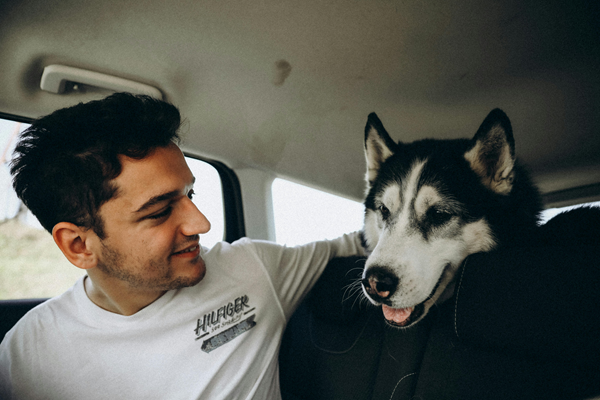GET 15% OFF WITH THE PUPPY BUNDLE
GET 15% OFF WITH THE PUPPY BUNDLE
Shop all

Emergency Preparedness 101: Keeping Your Dog Safe During Pet Preparedness Month
June 11, 2024 4 min read
Imagine this: You're curled up with your pup on the couch, enjoying a cozy movie night. Suddenly, the sirens wail outside, and the weather report flashes warnings of a fast-approaching storm. Your heart starts racing – you know you need to evacuate, but what about your furry best friend?
June is National Pet Preparedness Month, a timely reminder that emergencies can strike anytime. While staying safe yourself is crucial, it's equally important to have a plan to keep your four-legged companion safe too. Don't worry, pup parents – we can show you how to prepare for the unexpected!
Creating a Pawsome Emergency Plan for Your Dog
Think of your pet emergency plan as a superhero cape for your pup. It empowers you to face any situation with confidence, knowing your furry friend will be taken care of. Here's how to craft your very own:
Let's face it, emergencies can be chaotic. That's why having a clear contact list is like having a guardian angel for your furry best friend on speed dial. Here's who to include:
- Veterinarian: Your pet's primary healthcare provider should be the first contact on your list. Make sure to include their office number, after-hours emergency line, and address for quick reference.
- Emergency Vet Clinic: In case of after-hours emergencies or when your regular vet is unavailable, having the contact information for the nearest emergency veterinary clinic is crucial. Keep their number saved in your phone and know their location ahead of time.
- Trusted Friends or Family: Identify trusted friends, family members, or neighbors who can assist in case of an emergency. Share your pet's medical history and care instructions with them, and make sure they have access to your home in case you're unable to get there.
- Pet Sitter or Dog Walker: If you regularly use a pet sitter or dog walker, include their contact information on your list. They can provide crucial support during emergencies and ensure your pet's needs are met if you're unable to be there.
- Animal Poison Control: Keep the number for a poison control hotline specifically for pets handy. In case of accidental ingestion or exposure to toxins, quick action can be lifesaving.
Microchip Your Dog and Keep Those ID Tags Jangling
If you get separated from your dog, a microchip is like a tiny GPS tracker implanted under your dog's skin. It holds their unique identification information, making it much easier for them to be reunited with you. Plus, don't underestimate the power of a brightly colored ID tag with your current contact information.
Choosing Your Dog's Fortress of Solitude
Where will your pup stay safe during an emergency? Consider pet-friendly hotels or shelters if evacuation is necessary. If staying put is your only option, designate a safe room inside your house – an interior room away from windows is ideal.
Packing Your Dog's Travel Bag
Think of your dog's travel bag as a mobile doggy haven. Here are the essentials to pack:
- Leash & Dog Travel Crate: A sturdy leash, harness, and a comfortable dog travel crate should be in your pup's emergency kit.
- Food & Water Warriors: Pack at least a 3-day supply of your dog's food and water. Don't forget a pet travel bowl for on-the-go hydration!
- Medications & Munchies: If your dog takes any medication, include an extra supply. Throw in some of their favorite toys and calming treats to keep them stress-free.
- Clean-Up Crew: Pack some pet waste bags and sanitation wipes to keep things tidy, even during emergencies.
- Paper Towels & Sanitizer: Accidents happen, so pack paper towels and disinfectant to keep your pup's area clean.
- Medical Records & Memories: Include a copy of your dog's medical records and a recent photo of you both for identification purposes.
Keeping Your Dog Safe: Beyond the Basics
Having a plan and a travel bag is a great start, but here are some additional ways to ensure your dog's well-being during an emergency:
Stay Calm & Lead by Example: Dogs pick up on our emotions. Staying calm and collected during an emergency will help keep your dog feeling safe and secure.
Consider a Buddy System: If you have a neighbor or friend who is also a pet owner, create a buddy system where you can look out for each other's pets during an emergency.
Prepare for Different Emergencies: Tailor your plan to address different types of emergencies. For example, during a heatwave, ensure your dog has access to plenty of shade and cool water.
First-Aid: Learn basic pet first-aid techniques, such as recognizing signs of shock and performing CPR on a dog. Consider taking a pet first-aid course offered by the Red Cross or a local veterinarian.
Harness the Power of Technology: There are plenty of pet-tracking apps and microchip services available. Explore these options to give yourself extra peace of mind.
Emergencies can be stressful for everyone, but with a little planning and preparation, you can ensure the safety of your furry companion. Take action today, create your pet emergency plan, and embrace the peace of mind that comes with knowing you're prepared for anything. Happy Pet Preparedness Month!
Leave a comment
Comments will be approved before showing up.





